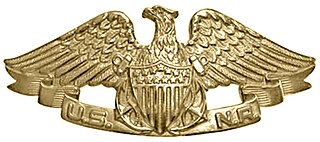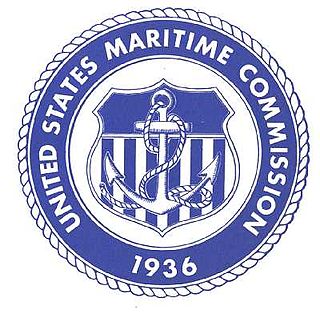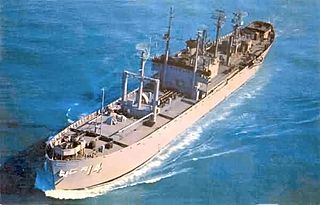The United States Armed Forces are the military forces of the United States. It consists of the Army, Marine Corps, Navy, Air Force, Space Force, and Coast Guard. The president of the United States is the commander-in-chief of the Armed Forces and forms military policy with the Department of Defense (DoD) and Department of Homeland Security (DHS), both federal executive departments, acting as the principal organs by which military policy is carried out. All six armed services are among the eight uniformed services of the United States.
The United States has eight federal uniformed services that commission officers as defined by Title 10 and subsequently structured and organized by Title 10, Title 14, Title 32 and Title 42 of the U.S. Code.
A midshipman is an officer of the lowest rank, in the Royal Navy, United States Navy, and many Commonwealth navies. Commonwealth countries which use the rank include Canada, Australia, Bangladesh, Namibia, New Zealand, South Africa, India, Pakistan, Singapore, Sri Lanka, and Kenya.

The United States Merchant Marine refers to either United States civilian mariners, or to U.S. civilian and federally owned merchant vessels. Both the civilian mariners and the merchant vessels are managed by a combination of the government and private sectors, and engage in commerce or transportation of goods and services in and out of the navigable waters of the United States. The Merchant Marine primarily transports cargo and passengers during peacetime; in times of war, the Merchant Marine can be an auxiliary to the United States Navy, and can be called upon to deliver military personnel and materiel for the military. Merchant Marine officers may also be commissioned as military officers by the Department of Defense. This is commonly achieved by commissioning unlimited tonnage Merchant Marine officers as Strategic Sealift Officers in the United States Navy Reserve.
The United States service academies, also known as the United States military academies, are federal academies for the undergraduate education and training of commissioned officers for the United States Armed Forces.

The United States Merchant Marine Academy is a United States service academy located in Kings Point, New York. It trains officers to serve in United States Merchant Marine, branches of the military, and the transportation industry. Midshipmen are trained in different fields such as marine engineering, navigation, ship's administration, maritime law, personnel management, international law, customs, and many other subjects important to the task of running a large ship.

The United States Department of the Navy (DN) is one of the three military departments within the Department of Defense of the United States of America. The Department of the Navy was established by an Act of Congress on 30 April 1798, to provide a government organizational structure to the United States Navy (USN), the United States Marine Corps (USMC) and, when directed by the President, the United States Coast Guard (USCG), as a service within the Department of the Navy, though each remain independent service branches. The Department of the Navy was an Executive Department and the Secretary of the Navy was a member of the President's cabinet until 1949, when amendments to the National Security Act of 1947 changed the name of the National Military Establishment to the Department of Defense and made it an Executive Department. The Department of the Navy then became, along with the Department of the Army and Department of the Air Force, a Military Department within the Department of Defense: subject to the authority, direction and control of the Secretary of Defense.

Naval Reserve Merchant Marine Insignia was a breast insignia of officers in the United States Merchant Marine who also served in the United States Navy or United States Navy Reserve. The insignia was replaced by the Strategic Sealift Officer Warfare Insignia (SSOWI) in June 2011, per OPNAVINST 1534.1D.

The United States Maritime Commission (MARCOM) was an independent executive agency of the U.S. federal government that was created by the Merchant Marine Act of 1936, passed by Congress on June 29, 1936, and replaced the United States Shipping Board which had existed since World War I. It was intended to formulate a merchant shipbuilding program to design and build five hundred modern merchant cargo ships to replace the World War I vintage vessels that comprised the bulk of the United States Merchant Marine, and to administer a subsidy system authorized by the Act to offset the cost differential between building in the U.S. and operating ships under the American flag. It also formed the United States Maritime Service for the training of seagoing ship's officers to man the new fleet.

The United States Navy Reserve (USNR), known as the United States Naval Reserve from 1915 to 2005, is the Reserve Component (RC) of the United States Navy. Members of the Navy Reserve, called reservists, are enrolled in the Selected Reserve (SELRES), the Individual Ready Reserve (IRR), the Full Time Support (FTS), or the Retired Reserve program.

The United States Maritime Service (USMS) was established in 1938 under the provisions of the Merchant Marine Act of 1936 as voluntary organization to train individuals to become officers and crewmembers on merchant ships that form the United States Merchant Marine per 46 U.S.C. § 51701. Heavily utilized during World War II, the USMS has since been largely dissolved and/or absorbed into other federal departments, but its commissioned officers continue to function as administrators and instructors at the United States Merchant Marine Academy and the several maritime academies.

USS Interpreter (AGR-14) was a Guardian-class radar picket ship, converted from a Liberty Ship, acquired by the US Navy in 1957. She was reconfigured as a radar picket ship and assigned to radar picket duty in the North Pacific Ocean as part of the Distant Early Warning Line.
USNS Rollins (T-AG-189) was one of 12 ships scheduled to be acquired by the United States Navy in February 1966 and converted into forward depot ships and placed into service with the Military Sea Transport Service. SS High Point Victory (MCV-851) was chosen for this conversion and assigned the name Rollins but the program was canceled and the ships were not acquired by the Navy.
The SS Lindenwood Victory was a Victory-class cargo ship built during World War II. The Lindenwood Victory was a type VC2-S-AP2 victory ship built by Permanente Metals Corporation, Yard 2, of Richmond, California. The Maritime Administration cargo ship was the 766th ship built. Her keel was laid on May 12, 1945. SS Lindenwood Victory was an armed cargo ship She was built in just 70 days, under the Emergency Shipbuilding program for World War II. SS Lindenwood Victory was an armed cargo ship, named for Lindenwood University in St. Charles, Missouri, one of 150 educational institutions that had Victory ships named after them. The 10,600 ton ship was constructed for the Maritime Commission.

The Marine Forces Reserve, also known as the United States Marine Corps Reserve (USMCR) and the U.S. Marine Corps Forces Reserve, is the reserve force of the United States Marine Corps. It is the largest command, by assigned personnel, in the U.S. Marine Corps. Marines in the Reserve go through the same training and work in the same Military Occupational Specialties (MOS) as their active-duty counterparts. The United States Marine Corps Reserve was established when Congress passed the Naval Appropriations Act of 29 August 1916, and is responsible for providing trained units and qualified individuals to be mobilized for active duty in time of war, national emergency, or contingency operations.
The reserve components of the United States Armed Forces are military organizations whose members generally perform a minimum of 39 days of military duty per year and who augment the active duty military when necessary. The reserve components are also referred to collectively as the National Guard and Reserve.

The South Carolina Naval Militia (SCNM) is the naval militia of the state of South Carolina. The SCNM is a naval unit organized at state level and primarily composed of Navy and Marine Corps reservists who serve simultaneously as federal and state level reservists. The SCNM can be deployed by the Governor of South Carolina to assist in emergency response or in homeland security operations.

SS Elmira Victory was a Victory ship built during World War II under the Emergency Shipbuilding program. It was built and launched by the Oregon Shipbuilding Corporation on May 12, 1944 and completed on May 31, 1944. The ship's United States Maritime Commission designation was VC2-S-AP3 and hull number 105 (1021). The ship was Oregon Shipbuilding Corporation's 21st victory ship. The Maritime Commission turned it over for Merchant navy operation to a civilian contractor, the Isthmian Steamship Company under the United States Merchant Marine act for the War Shipping Administration. She was named after the city of Elmira, New York.

The SS Minot Victory was a Victory ship built during World War II under the Emergency Shipbuilding program. It was laid down and launched by the Oregon Shipbuilding Corporation, and completed on February 1, 1945. The ship's United States Maritime Commission designation was VC2-S-AP3 and hull number 149 (1203). The Maritime Commission turned it over for merchant navy operation to a civilian contractor, the Isthmian Steamship Company under the United States Merchant Marine act for the War Shipping Administration. She was named after Minot, Maine and Minot, North Dakota.

The SS Bucknell Victory was a Victory-class cargo ship built during World War II. The Bucknell Victory was a type VC2-S-AP2 victory ship built by Permanente Metals Corporation, Yard 2, of Richmond, California. The Maritime Administration cargo ship was the 728th ship built. Her keel was laid on December 27, 1944. SS Bucknell Victory was an armed cargo ship, named for Bucknell University in Pennsylvania, one of 150 educational institutions that had Victory ships named after them. She was built in just 70 days, under the Emergency Shipbuilding program for World War II. The 10,600 ton ship was constructed for the Maritime Commission.











